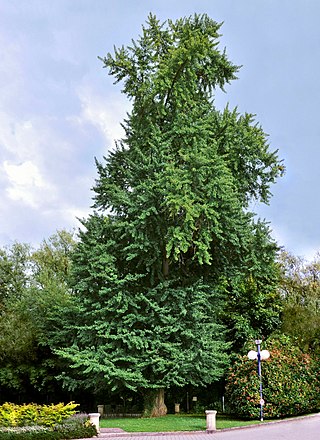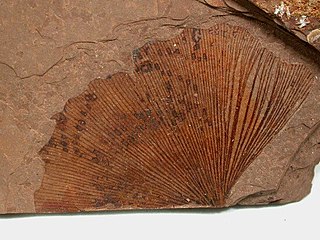
Dermatitis is inflammation of the skin, typically characterized by itchiness, redness and a rash. In cases of short duration, there may be small blisters, while in long-term cases the skin may become thickened. The area of skin involved can vary from small to covering the entire body. Dermatitis is often called eczema, and the difference between those terms is not standardized.

Ginkgo biloba, commonly known as ginkgo or gingko, also known as the maidenhair tree, is a species of tree native to China. It is the last living species in the order Ginkgoales, which first appeared over 290 million years ago. Fossils very similar to the living species, belonging to the genus Ginkgo, extend back to the Middle Jurassic approximately 170 million years ago. The tree was cultivated early in human history and remains commonly planted.

Ginkgoales are a gymnosperm order containing only one extant species: Ginkgo biloba, the ginkgo tree. It is monotypic, within the class Ginkgoopsida, which itself is monotypic within the division Ginkgophyta. The order includes five families, of which only Ginkgoaceae remains extant.

Urushiol is an oily mixture of organic compounds with allergenic properties found in plants of the family Anacardiaceae, especially Toxicodendronspp., Comocladia spp. (maidenplums), Metopium spp. (poisonwood), and also in parts of the mango tree as well as the fruit of the cashew tree. In most individuals, urushiol causes an allergic skin rash on contact, known as urushiol-induced contact dermatitis.

Contact dermatitis is a type of acute or chronic inflammation of the skin caused by exposure to chemical or physical agents. Symptoms of contact dermatitis can include itchy or dry skin, a red rash, bumps, blisters, or swelling. These rashes are not contagious or life-threatening, but can be very uncomfortable.

Bilobalide is a biologically active terpenic trilactone present in Ginkgo biloba.

Ginkgolides are biologically active terpenic lactones present in Ginkgo biloba. They are diterpenoids with 20-carbon skeletons, which are biosynthesized from geranylgeranyl pyrophosphate.
Sesquiterpene lactones (SLs) are a class of sesquiterpenoids that contain a lactone ring. They are most often found in plants of the family Asteraceae. Other plant families with SLs are Umbelliferae and Magnoliaceae (magnolias). A collection of colorless, lipophilic solids, SLs are a rich source of drugs. They can be allergenic and toxic in grazing livestock causing severe neurological problems in horses. Some are also found in corals such as Maasella edwardsi.

Lipofuscin is the name given to fine yellow-brown pigment granules composed of lipid-containing residues of lysosomal digestion. It is considered to be one of the aging or "wear-and-tear" pigments, found in the liver, kidney, heart muscle, retina, adrenals, nerve cells, and ganglion cells.

Alkylresorcinols (ARs), also known as resorcinolic lipids, are amphiphilic phenolic lipids characterised by a non-polar odd-numbered alkyl side chain with up to 27 carbon atoms attached to a polar resorcinol (1,3-dihydroxybenzene) ring.
In botany, a zoid or zoïd is a reproductive cell that possesses one or more flagella, and is capable of independent movement. Zoid can refer to either an asexually reproductive spore or a sexually reproductive gamete. In sexually reproductive gametes, zoids can be either male or female depending on the species. For example, some brown alga (Phaeophyceae) reproduce by producing multi-flagellated male and female gametes that recombine to form the diploid sporangia. Zoids are primarily found in some protists, diatoms, green alga, brown alga, non-vascular plants, and a few vascular plants. The most common classification group that produces zoids is the heterokonts or stramenopiles. These include green alga, brown alga, oomycetes, and some protists. The term is generally not used to describe motile, flagellated sperm found in animals. Zoid is also commonly confused for zooid which is a single organism that is part of a colonial animal.
GABA receptor antagonists are drugs that inhibit the action of GABA. In general these drugs produce stimulant and convulsant effects, and are mainly used for counteracting overdoses of sedative drugs.
A phytosome is a complex of a natural active ingredient and a phospholipid - mostly lecithin.

Ginkgo is a genus of non-flowering seed plants. The scientific name is also used as the English name. The order to which it belongs, Ginkgoales, first appeared in the Permian, 270 million years ago, and is now the only living genus within the order. The rate of evolution within the genus has been slow, and almost all its species had become extinct by the end of the Pliocene. The sole surviving species, Ginkgo biloba is only found in the wild in China, but is cultivated around the world. The relationships between ginkgos and other groups of plants are not fully resolved.

Ginkgotoxin (4'-O-methylpyridoxine) is a neurotoxin naturally occurring in Ginkgo biloba. It is an antivitamin structurally related to vitamin B6 (pyridoxine). It has the capacity to induce epileptic seizures.

Ginkgo cranei is an extinct Ginkgo species in the family Ginkgoaceae described from a series of isolated fossil ovulate organs and leaves. The species is known from upper Paleocene sediments exposed in the state of North Dakota, USA. It is the first Ginkgo species to be described from Paleogene period with reproductive structures.
Adipostatin A is an alkylresorcinol, a type of phenolic lipids composed of long aliphatic chains and phenolic rings. Chemically, it is similar in structure to urushiol, the irritant found in poison ivy.
Streptomyces cyaneus is an actinobacterium species in the genus Streptomyces.

Ginkgo yimaensis is an extinct ginkgo species in the family Ginkgoaceae. It is a gymnosperm, first described by Zhou and Zhang.

6-Hydroxykynurenic acid is a constituent of ginkgo and an amino acid. It is a derivative of kynurenic acid and has similarly been found to antagonize AMPA and NMDA, as well as their corresponding receptors.














